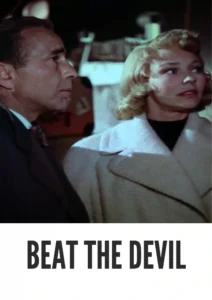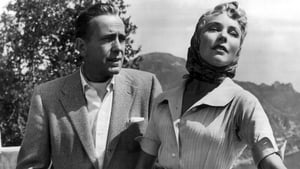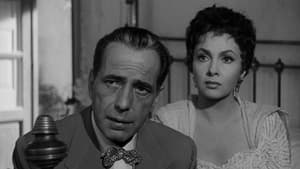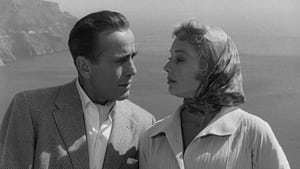Video Sources 0 Views
- Watch trailer
- Beat the Devil 1953 Colorized


Synopsis
Table of Contents
Toggle
Dive into the quirky world of Beat the Devil, a 1953 cult comedy adventure directed by John Huston, now brilliantly colorized to bring a fresh perspective to this timeless classic. This film, starring the legendary Humphrey Bogart, offers a unique blend of satire, suspense, and outright silliness set against the backdrop of the Italian coastline. Ideal for those who appreciate unconventional humor and the charisma of classic Hollywood stars, this HD download allows you to enjoy a visually enhanced version of a film that defied expectations and became a beloved cult favorite.
Beat the Devil follows the escapades of a group of eccentric characters all vying for ownership of uranium-rich land in British East Africa. Humphrey Bogart plays Billy Dannreuther, an American adventurer down on his luck, accompanied by his wife Maria (Gina Lollobrigida). They become entangled with a bizarre cast of characters, including a British couple, the Chelms, and a suspicious group of Germans led by the enigmatic Peterson.
As they all journey aboard a tramp steamer bound for Africa, their plans are constantly thwarted by mishaps, double-crosses, and absurd situations. The dialogue is sharp, witty, and often nonsensical, adding to the film’s unique charm. The plot thickens with each passing scene as the characters scheme, flirt, and outwit one another in a desperate attempt to secure their fortunes. The film culminates in a series of unpredictable events, solidifying Beat the Devil‘s status as a truly original and unforgettable cinematic experience. It is known by several other titles in other countries including Qualcuno হানছে in Italy and La mano del diavolo in Spain
The film boasts an impressive ensemble cast, each bringing their unique talents to this comedic caper:
-
Humphrey Bogart as Billy Dannreuther
-
Jennifer Jones as Gwendolen Chelm
-
Gina Lollobrigida as Maria Dannreuther
-
Robert Morley as Peterson
-
Peter Lorre as O’Hara
Beat the Devil defies easy categorization, blending elements of comedy, adventure, and satire. Its unique tone and unconventional narrative structure make it a standout in the realm of classic cinema, appealing to those who appreciate films that break the mold.
Released in 1953, Beat the Devil represented a departure from the conventional Hollywood fare of the time. Director John Huston and writer Truman Capote intentionally set out to create a film that poked fun at the thriller genre, resulting in a production that was as chaotic behind the scenes as it was on screen. Despite initial mixed reviews, the film has since gained a cult following for its irreverent humor and star-studded cast. Beat the Devil stands as a testament to the creative risks taken during the Golden Age of Hollywood.
This colorized version of Beat the Devil has been meticulously crafted using state-of-the-art digital technology, enhancing the visual experience while preserving the film’s original charm. The colorization process involved a detailed analysis of the film’s grayscale tones, ensuring that the colors added were both accurate and aesthetically pleasing. The result is a vibrant and engaging viewing experience that breathes new life into this classic film. While the debate over colorizing black and white films continues, this version aims to introduce Beat the Devil to a new generation of viewers, ensuring its enduring legacy.
-
: John Huston
-
: Truman Capote, John Huston
-
: the novel by James Helvick
-
: Oswald Morris
-
: Ralph Kemplen
-
: Santana Productions
-
: United Artists
-
: 89 minutes
-
: MP4
-
: HD (1080p)
-
: Compatible with a wide range of devices, including smartphones, tablets, computers, and smart TVs.
Beat the Devil (1953) initially received mixed reviews but has since been re-evaluated as a cult classic. Its unique blend of humor, satire, and adventure has garnered a dedicated following, with many praising its witty dialogue and stellar performances. As an unconventional and often misunderstood film, Beat the Devil offers a refreshing alternative to traditional Hollywood fare.
-
: What is Beat the Devil about?
-
A: Beat the Devil is a comedic adventure about a group of people scheming to acquire uranium-rich land in Africa.
-
-
: Is Beat the Devil (1953) a well-known film?
-
A: While not initially a mainstream success, Beat the Devil has gained a cult following over the years for its unique humor and star-studded cast.
-
-
: Is this version of Beat the Devil colorized?
-
A: Yes, this version has been professionally colorized to provide a visually enhanced viewing experience.
-
-
: What makes Beat the Devil interesting for film enthusiasts?
-
A: Beat the Devil offers a unique blend of genres and a behind-the-scenes story as intriguing as the film itself, appealing to those who appreciate unconventional cinema.
-
-
: What is the download format?
-
A: The download format is MP4, ensuring compatibility with most devices.
-
-
: What resolution is the download?
-
A: The resolution is HD (1080p), providing a high-quality viewing experience.
-
Experience Beat the Devil Today!














